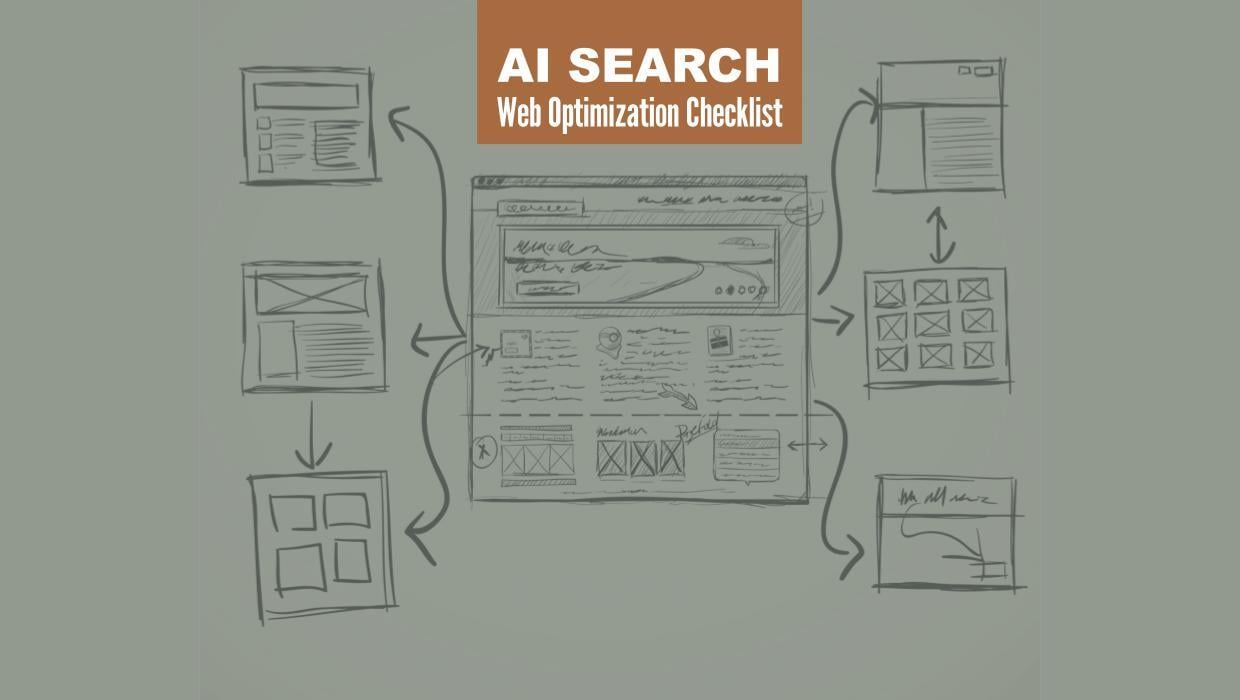10 Easy Ways to Generate Content Marketing Ideas for Manufacturers
Written by
Usually all it takes for a stream of manufacturing-focused content ideas to dry up is a blank screen, a blinking cursor, and a deadline. Where do you turn to fight copywriting vapor-lock or for inspiration when it feels like there’s nothing new in content marketing for manufacturers?
Engaging, manufacturing-relevant B2B content marketing topics are likely closer than you think. Use these 10 easy and proven methods to find them:
- Consult Artificial Intelligence
- Use SEO tools for keyword research and SERP analysis
- Know your audience and supplement with intelligence tools
- Interview your company’s subject matter experts (SMEs)
- Review and engage with customer/audience feedback
- Share key takeaways
- Brainstorm together
- Listen to the Voice of the Customer (VOC)
- Repurpose existing content
- Humble brag (with a purpose)
1. Consult Artificial Intelligence
AI is an obvious game changer when it comes to content marketing. However, there’s the somewhat expected — and completely NOT recommended — way to leverage the tool by typing in a few prompts and relying on AI to write content for you. This shortcut is lazy, counterproductive, and frankly, it’s dangerous to assume AI accuracy.
Then, there’s the right way to befriend AI and leverage it for industrial content marketing. The speed with which AI can gather information can greatly speed up research and enhance ideation. Being able to parse data and trends is powerful in identifying personalized and relevant content for discerning B2B audiences.
Large Language Models such as ChatGPT can be a great sounding board for experimenting with:
- topic ideation and suggestions,
- creative approaches to traffic-drivers like headlines and meta descriptions
- and even initial drafts that capture your ideas for further refinement — which results in, ultimately, original content creation
One of the beauties of generative AI advancements is the extreme efficiency in a supporting role to content creators. The speed and wealth of data generated in response to a series of prompts provides us as content managers with new paths to explore, the opportunity to validate existing strategies, and serves to align content with market dynamics and customer needs. The result? We can create more impactful content that drives better engagement and results.
2. Use SEO tools
SEO software platforms such as SEMRush, Moz, Clearscope, and others are key in providing actionable insights and functionalities that enhance content effectiveness, visibility, and relevance.
We use SEO tools like these on the daily to craft client strategies by digging into keywords, competitive analysis, tracking, and analytics that frame content performance. Traffic, engagement, and conversion metrics inform our decisions about content optimization for search engines.
In turn, we use the SEO analyzer tools in SEMrush to get instant, detailed information about how to improve our content — from keyword usage, meta tags, readability, and certain other on-page SEO analytics that define how the content resonates with and reaches target audiences.

3. Know your audience
You can’t engage an audience you don’t know.
Audience research tools are only getting better at helping industrial content marketers develop and leverage deeper connections because they answer the when, where, and how of how targets spend their time online.
Armed with this information, marketers can be intentional about how and where to talk to the people most likely to align with ideal customer profiles and company goals. SparkToro is our favorite tool for identifying common influences among target audience members so you can craft content that has influence in the right channels.
We've seen firsthand how using SparkToro's tools can help improve content relevance and distribution, which translates to content that is more likely to convert and retain customers, and boost content marketing ROI.
RELATED: Why & How to Conduct Audience Research for Inbound Marketing
4. Interview SMEs
Subject matter experts (SMEs) are exceptionally beneficial to content marketers. SMEs might be on your team, or that of your customer. Maybe both.
The knowledge and practical experience they bring to interviews are credibility boosters, and their insights are often nuanced — meaning greater potential for gleaning several thought leadership topics that address all facets of the buyer’s journey.
Moreover, SMEs are the voice of authority your prospects listen to when solving challenges or exploring opportunities. The trust elicited by expert-backed content can help attract and convert higher-quality leads, keep them engaged during decision making, and grow long-term relationships.
(Pro tip: it's also the kind of first-person, firsthand experience Google is looking for in content that ranks high in SERPs.)
5. Review and engage with feedback
Social media conversations are great fodder for content. Use your blog to answer questions that customers are asking on your LinkedIn and Facebook pages and other social platforms, or look to comments left on industry articles, or trade community sites for fresh perspectives on popular topics.
Poke around in customer reviews of your products and services for recurrent themes. Also consider digging into FAQ pages — your own and those of competitors — to leverage evergreen discussions and challenges as manufacturing blog content ideas.
Tap into trending topics in your industry through LinkedIn Groups, Facebook Community pages, and X hashtag feeds. Reddit communities (subreddits) are content idea generation gold. Professionals from all types of industries provide their takes on industry trends, insights, and innovations, and answer questions from other community members in the conversation threads — also a perfect opportunity for engagement of your own. With 52 million daily active users and more than 430 million monthly active users globally, reddit is a social platform not to be ignored in industrial content marketing. Feel "too out of touch" for Reddit? Don't. Start here.
Being aware of and leveraging questions and comments that appear on your various social platforms is more than a content idea driver. It helps you craft posts that are relevant to your target buyer personas and existing audiences, and creates opportunities to attract new prospects. It's also, quite frankly, table-stakes for any business in 2024.
6. Share key takeaways
Think about the many ways you access content for your own learning and development on a daily basis. In a single week as a content manager, I often consume seminars, webinars, workshops, trends and statistics, trade shows, trade publications, competitive analysis — the list goes on. Within that content are key insights that, when shared, can provide the basis for individual or multi-part blog articles, advanced content, social posts, short-form video, and more. If I'm doing the work to learn something my network may also find valuable, I may as well also put it to work for my marketing efforts!
Using the takeaways to inform your content could also provide opportunities to distinguish your brand and SMEs as industry thought leaders, a valuable distinction that can translate to a significant competitive advantage.
7. Brainstorm
You’re not creating content ideas in a vacuum. Brainstorm with coworkers, and compile a list of topics that surface.
While theoretically there is no such thing as a bad idea, it’s worth your time to take a more strategic approach to who you ask for input. Your sales team, for example, is a perfect group for brainstorming topics that matter to your audience. They regularly communicate with customers and prospects, deeply understand their buying journeys, and field everything from general questions to major concerns — an ideal topic goldmine for savvy B2B marketers.
8. Listen to the Voice of the Customer (VOC)
Hearing first-hand about your business from industry partners, employees, and customers is an effective way to find enthusiastic brand evangelists. It’s great validation, but how do glowing and maybe not-so glowing reviews translate to content ideas?
Sure, the occasional article wherein a customer sings your praises is expected. But, implementing a voice of the customer (VOC) program gets you much closer to understanding what your customers want and feel. Prevalent VOC concerns, challenges, and learnings may be distilled into relevant and insightful content.
9. Repurpose existing content
Chances are you have resources on your website that are already traffic drivers. A quick review of your website analytics will reveal a guide that’s resonating with your target audiences, a must-have fact sheet that’s going boffo, or other high-performing marketing assets. Don’t view these content pieces as untouchable — instead, commit to regularly refreshing them to keep them current, citing the most recent data and trends relevant to manufacturing.
There’s also the power of video to consider. In 2024, an estimated 91% of businesses use video as a marketing tool — which means you’re likely in that percentage. So you probably know that video is an effective messaging medium. Because you can pack a lot of info into a little time, video is effective at influencing buyers at the earliest stages of their journey to purchase decisions.
Viewing on-demand video, like live events repurposed into webinars, also keeps website visitors around for a while, making for a nice on-page engagement boost. They also give you some content latitude. For instance, a blog article might expound on the main webinar topic from a fresh perspective, or it could simply provide a transcript of the session.
RELATED: Never Run Out of Great Blog Ideas! 40+ Blog Topic Tips for Your Business
10. Humble brag (with a purpose)
Excessively patting yourself on the back is one of the surest ways to create content that disengages industrial buyers. However, it’s advisable to slide a little humble bragging into your marketing plan that serves a purpose.
- Showcase your accomplishments in case studies that celebrate your customers’ successes.
- Provide insightful white paper overviews to demonstrate thought leadership.
- Debunk popular industry myths by discussing how your products and services solve similar, actual manufacturing challenges.
Using these types of illustrative examples demonstrates your sincere interest in showing up to help customers instead of merely showing off for them.
Content marketing ideas for manufacturers don’t have to be feast or famine. Thoughtfully leveraging information you already have or can readily access may provide the needed variety. You can find inspiration by digging into the data surrounding B2B industrial manufacturers’ marketing challenges and triumphs compiled in our State of Industrial Sales & Marketing Report.
Subscribe To Our Blog
Information. Insights. Ideas. Get notified every time a new Weidert Group blog article is published – subscribe now!
You May Also Like...

Search Engine Optimization
Optimize Your Industrial Website for AI Search

Marketing Technology
Why Unified Data Efforts Fail (and How Manufacturers Can Fix It)

Search Engine Optimization
How Falcon Rebuilt Industrial AI Search Visibility in 2025
Accelerate Your Growth with
Weidert Group
If you’re ready to explore a partnership, request a personalized consultation with our team.

